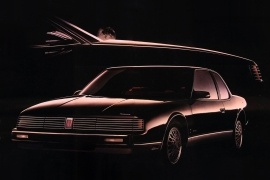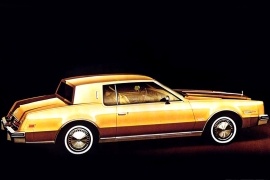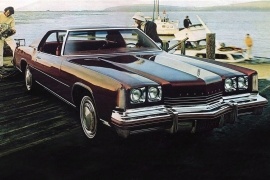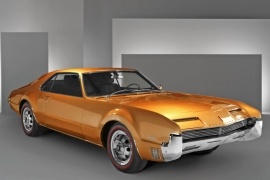OLDSMOBILE Toronado Models/Series Timeline, Specifications & Photos
First production year: 1966
Engines: Gasoline
The fourth and last generation of the Toronado debuted on the market in 1985 as a 1986 model year, dropped the V8 engines, and introduced a futuristic, for those times, interior.
Two decades after the introduction of the revolutionary 1966 Toronado as a personal luxury coupe, the 1986 Toronado was just a small-sized coupe that offered room for four but with two people squeezed in the back. In addition, it lost its grunt and performance without providing too much comfort in exchange.
By 1986, the car design had changed a lot, and the Toronado followed the trend of narrowing the front area. Thus, the carmaker brought back the hidden headlights, a feature that was dropped in 1969, and also covered the main grille. A lower grille was mounted below the front bumper in the apron to compensate for the cooling area. Still, the profile showed clean lines and a short window next to the rear passengers. Unfortunately, that couldn't be opened. The rear wheels were placed behind the greenhouse, and that made the vehicle look unusual.
Inside, the driver found themselves surrounded by plenty of buttons and switches. These were everywhere, from the door cards to the dashboard, center stack, and center console. In addition, a digital instrument panel was installed and showed green LEDs that displayed speed and other essential information. Since Oldsmobile still tried to promote the vehicle as a personal luxury coupe, it offered it with either velour or leather upholstery.
Under the hood, the Toronado featured a transversely-mounted V6 carried over from Buick and coupled with a four-speed automatic transmission only.
The third generation of the Toronado marked a serious downsizing for the once imposing personal luxury coupe offered by Oldsmobile.
During the "Malaise Era," the Toronado lost its powerful engines and its big size. But all that changed in 1978 when the 1979 model year appeared on the market. Starting with that year, the CAFE agreement came into force, and Oldsmobile had to shrink its elegant coupe. In addition, it was the first (and only) generation of this nameplate that featured a diesel engine.
The car's look was still imposing thanks to its flat front fascia fitted with four rectangular headlights and the chromed, pinned-out radiator. However, from its profile, the design team managed to create an elegant look for this vehicle with a slightly sloped-down, short deck.
Inside, the automaker installed a split bench at the front. Later on, Oldsmobile also added bucket seats to the options list. The tall dashboard featured a squared-looking instrument cluster in front of the driver and a center stalk where the audio and AC controls were placed. In the back, there was enough room for two adults on the comfortable bench.
The 1979 Toronado was the first to receive an independent rear suspension carried over from Cadillac. Thus, it was more comfortable and featured better road-holding than its predecessor. In addition, since the car was almost 1,000 lbs (450 kg) lighter than its predecessor, it offered improved fuel efficiency. Under the hood, Oldsmobile installed a choice of four engines: three with gasoline and one oil burner. Between 1979 and 1981, the transmission was a three-speed automatic, and starting with 1981, it was replaced by a four-speed auto.
The second generation of the Oldsmobile Toronado was introduced in 1971, at the dusk of the muscle-car era. It was marketed as a personal luxury coupe.
At the beginning of the '70s, most of the cars on the market were still rear-wheel-drive and it was considered the only way to put more torque to the ground. The Oldsmobile thought another way: the front-wheel-drive solution will be the future, and they were right. So, they built the Toronado on a new platform and sent all the power to the front wheels.
Long, wide, and with edges on the fenders and slightly sculptured door panels, the Toronado was an all-American GT cruiser. It wasn't built for fast, curved roads, but for long and comfortable trips. The front featured four round headlights covered with a lid when the lights were off. In the back, the Toronado introduced a new set of taillights, used for braking and as a turn-signal. That system became standard afterward for most of the American cars.
Inside, there was a wide bench in the front where three people could sit in comfort. The dashboard was built around the driver. The instrument cluster featured a square dial for the speedometer and an AM/FM-8 Track stereo on the center stack. The gear-selector was mounted on the steering column. The car featured power-windows, power-locks, air-conditioning, and ABS for the rear axle. For the rear passengers, the Toronado offered a wide bench as well.
Under the hood, the big coupe was offered with a 7.5-liter V8 unit mated to a standard 3-speed gearbox. Despite its big displacement, the engine offered just 270 hp, which was not that much for a 2-ton vehicle.
In 1965 Oldsmobile introduced one of the most revolutionary cars in the American automotive industry, the front-wheel drive Toronado.
Even though it wasn't the first FWD vehicle in the American automotive world, it was a big change. It came in the mid-60s, at the beginning of the muscle car era. Its styling was dynamic, its drivetrain was unique, and the interior featured unusual amenities. For short, it was a revolution.
The styling showed a clean design with flat, slightly curved surfaces but with enlarged wheel arches. At the front, the pop-up headlights were flanked by taller fenders that pointed up and forward like aerodynamic knives. Its grille was also spread from one side to another of the vehicle, lower than the headlights and above the chromed, integrated metallic bumper. From its profile, the sloped-down greenhouse and trunk line offered a dynamic look for the vehicle.
Inside, the automaker placed a pair of bucket seats at the front and a bench in the back. On the dashboard, the speedometer showed a "slot-machine" styling, where the numbers were marked with white letters on a barrel that rotated behind a thin line. But that was not the only peculiarity of the vehicle. The doors featured opening handles on their rearmost side, so the back-seat passengers could open them by themselves.
Under the hood was a longitudinally mounted V8 powerplant paired with a newly developed three-speed automatic transmission that sent the power to the front wheels.



